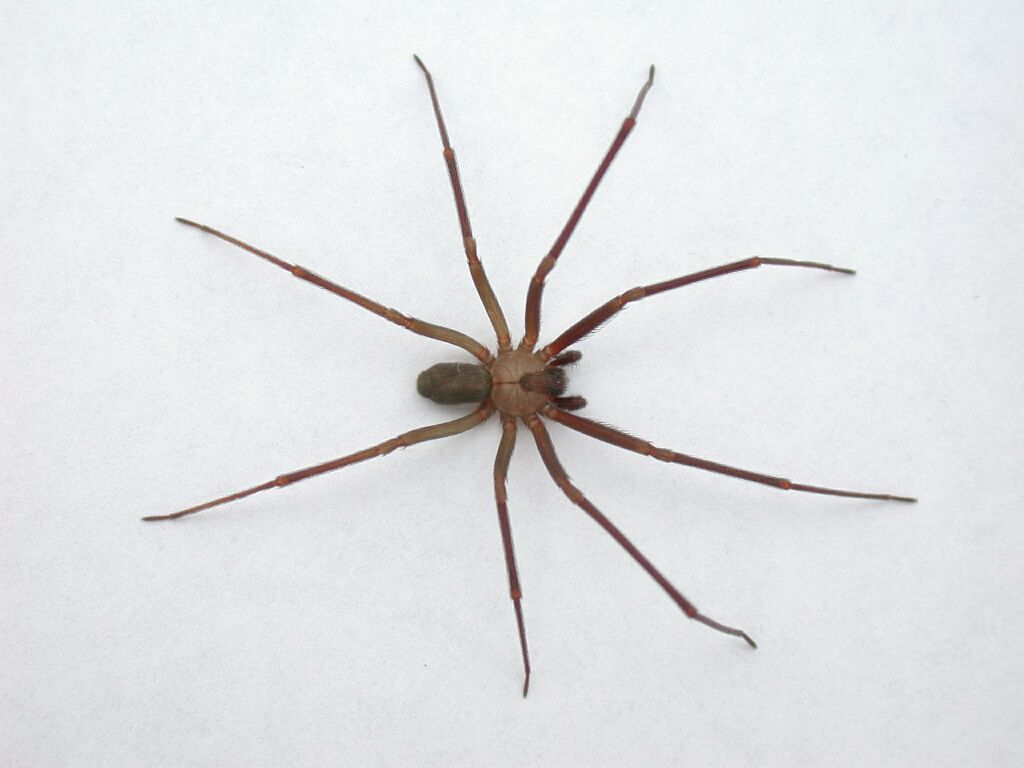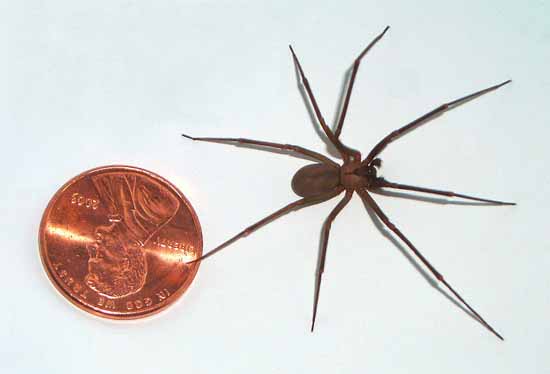Brown Recluse


Brown recluse spiders are usually between 6–20 mm (¼ in and ¾ in), but may grow larger. While typically light to medium brown, they range in color from cream-colored to dark brown or blackish gray. The cephalothorax and abdomen may not necessarily be the same color. These spiders usually have markings on the dorsal side of their cephalothorax, with a black line coming from it that looks like a violin with the neck of the violin pointing to the rear of the spider, resulting in the nicknames fiddleback spider, brown fiddler or violin spider.
Since the violin pattern is not diagnostic, and other spiders may have similar markings (such as cellar spiders and pirate spiders), for more assurance in identification it is imperative to examine the eyes. Most spiders have eight eyes; recluse spiders have six eyes arranged in pairs (dyads) with one median pair and two lateral pairs. Only a few other spiders have three pairs of eyes arranged in this way (e.g., scytodids). Recluses have no obvious coloration patterns on the abdomen or legs, and the legs lack spines. The abdomen is covered with fine short hairs that (viewed without magnification) give it the appearance of soft fur. The leg joints may appear to be a slightly lighter color.
A brown recluse's stance on a flat surface is usually with all legs radially extended. When alarmed it may lower its body, withdraw the forward two legs straight rearward into a defensive position, withdraw the rearmost pair of legs into a position for lunging forward, and stand motionless with pedipalps raised. The pedipalps in mature specimens are dark, quite prominent, and are normally held horizontally forward. When threatened it usually flees, seemingly to avoid a conflict, and if detained may further avoid contact with quick horizontal rotating movements. The spider does not usually jump unless touched brusquely, and even then its avoidance movement is more of a horizontal lunge rather than a vaulting of itself entirely off the surface. When running the brown recluse does not appear to leave a silk line behind when, which at any rate might make it more easily tracked when it is being pursued. Movement at virtually any speed is an evenly paced gait with legs extended. When missing a leg or two it appears to favor this same gait, although (presumably when a leg has been injured) it may move and stand at rest with one leg slightly withdrawn. During travel it stops naturally and periodically when renewing its internal hydraulic blood pressure that, like most spiders, it requires to renew strength in the legs.
Recluse spiders build irregular webs that frequently include a shelter consisting of disorderly threads. They frequently build their webs in woodpiles and sheds, closets, garages, plenum, cellars and other places that are dry and generally undisturbed. When dwelling in human residences they seem to favor cardboard, possibly because it mimics the rotting tree bark which they inhabit naturally. Also they have been encountered in shoes, inside dressers, in bed sheets of infrequently used beds, in clothes stacked or piled or left lying on the floor, inside work gloves, behind baseboards and pictures, and near sources of warmth when ambient temperatures are lower than usual. Human-recluse contact often is when such isolated spaces are disturbed and the spider feels threatened. Unlike most web weavers they leave these lairs at night to hunt. Males move around more when hunting; females tend to remain nearer their webs.
Brown recluses are rarely aggressive, and actual bites from the species are rare. The spider usually bites only when pressed against the skin, such as when tangled up within clothes, towels, bedding, inside work gloves, etc. Many human victims of brown recluse bites report having been bitten after putting on clothes that had not recently been worn or lying undisturbed on the floor. The initial brown recluse bite frequently is not felt and may not be immediately painful, yet such a bite can be serious.
The type of venom that the Brown Recluse has is a hemotoxic venom. This can be very deadly. When bitten the bite has a possibility of causing necrosis, although most bites are minor with no necrosis. However, a small number of bites do produce severe lesions; an even smaller number of bites produce severe symptoms. In one study of brown recluse bites, the incidence of skin necrosis was 37% and the incidence of systemic illness was 14%.
Most brown recluse spiders bites do not result in necrosis, let alone systemic effects. When both types of loxoscelism do result, systemic effects may occur before necrosis, as the venom spreads throughout the body in minutes. Debilitated patients, the elderly, and children may be more susceptible to systemic loxoscelism. The systemic symptoms that are most commonly experienced as the result of a brown recluse bite include nausea, vomiting, fever, rashes, and muscle and joint pain. Rarely, such bites can result in hemolysis, thrombocytopenia, disseminated intravascular coagulation, organ damage, and even death. Most fatalities are children under the age of seven or those with a weaker-than-normal immune system.
While it is important to note that the majority of brown recluse spider bites do not result in any symptoms, cutaneous symptoms occur as a result of such bites more frequently than systemic symptoms. In such instances, the bite forms a necrotizing ulcer that destroys soft tissue and may take months to heal, leaving deep scars. These bites usually become painful and itchy within 2 to 8 hours, pain and other local effects worsen 12 to 36 hours after the bite, and the necrosis develops over the next few days. Over time, the wound may grow to as large as 25 cm (10 inches) in extreme cases. The damaged tissue becomes gangrenous and eventually sloughs away.








